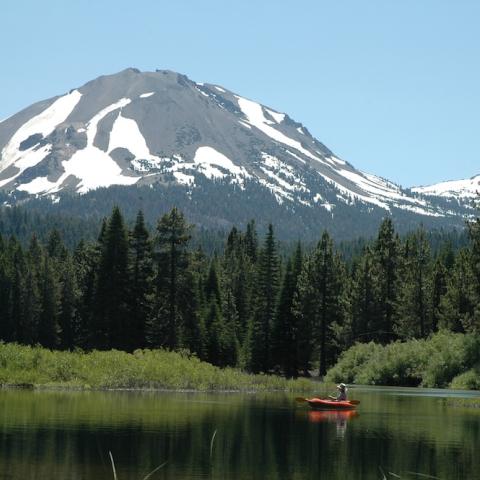
The Pioneer Fire was burning in the Boulder drainage above Stehekin Landing. This photo was taken August 2. A helicopter in the lower right-hand corner was dipping a bucket in Lake Chelan.
Wildfires continued Sunday to plague units of the National Park System, with Lassen Volcanic National Park still closed due to the proximity of the Park Fire to the west, multiple backcountry fires burning in Yosemite National Park, and several fires impacting North Cascades National Park.
The North Cascades fires in Washington state were causing the greatest problems for the National Park Service, with the Stehenkin area continuing under an evacuation area as crews try to blunt the encroaching 37,852-acre Pioneer Fire, while the 500-acre Ruby Fire had forced closure of the Colonial Creek South Campground and boat launch.
More than 600 firefighters were battling the Pioneer Fire, which was spotted August 6 and quickly blew up under hot and dry weather conditions and plentiful fuels.
"Abundant snags, heavy downed woody material, grasses, young conifer stands and shrub patches occupy most the landscape. The area is a mosaic of fuel patches with rock scree and outcrops serving as partial barriers to fire spread," the fire report stated. "Grasses are mostly cured, while shrubs and herbaceous fuels continue to dry due to hot summer weather, and are beginning to contribute to fire behavior."
In Stehekin, firefighters were working to protect structures along Lake Chelan with the use of sprinklers and burning fuels.
On Saturday, the use of three Large Air Tankers (LATs) and one Very Lage Air Tankers (VLATS) dropped 23,000 gallons of retardant on the fire's western edge along ridgetops above Boulder Creek, which is above Stehekin.
"Every [incident management] team before us has wanted to use retardant to stop the spread of this fire,” Incident Commander Tom Clemo said. “There just hasn’t been the alignment of location, flight paths, resources and several other issues to launch this capability. All those factors lined up yesterday and we took immediate advantage of the opportunity.”
The fire, just 13 percent contained, was said to be human-caused and under investigation.
Thunderstorms that moved through the park Friday sparked two more fires, the Riprap Fire, estimated at a tenth of an acre on Sourdough Mountain, and the Pierce Fire, estimated at 1 acre, on Pierce Mountain. Both fires were attacked with water drops. "Crews will assess the fires and prioritize with the resources available," park staff said.
In California, the Park Fire had grown to cover 429,188 acres with 37 percent containment. Nearly 6,100 firefighters were working to slow the fire's growth.
Thunderstorms had sparked six fires in Yosemite, though they were all at high elevation away from front-country infrastructure. Just two of the fires were being actively fought, the Middle and the Morrison fires.
The Middle Fire had burned more than 230 acres near the Middle Fork of the Tuolumne River, west of White Wolf Lodge. The firefighters were using a full suppression strategy utilizing ground crews and aircraft to suppress and contain the fire, a park report said.
"Fire crews are using ground and air resources, including handline construction with six fire crews, seven engine crews, and the help of two Type 1 and three Type 2 water-dropping helicopters," it said. "Structure protection preparations have been completed at White Wolf Lodge and Campground. There are no threats to Aspen Valley currently."
The Morrison Fire, also sparked by lightning, covered about 30 acres and firefighters were working to hold it at that size. "Fire crews are being inserted into this fire to monitor and hold. Fire crews will be using contain and confine tactics operations utilizing direct line construction and natural barriers," park staff said.
Four other fires in the park were a half-acre in size or less.




 Support Essential Coverage of Essential Places
Support Essential Coverage of Essential Places







Comments
Being that fire is a natural part of the environment, and that these are all fire-adapted ecosystems (which are unfortunately out of sync due to various human influences) I don't believe "Plague" is the appropriate term here.
There are 8 lightning strike caused wildfires in the backcountry of Sequoia-Kings Canyon NP, with one of them being a little too close to Three Rivers-the Coffeepot Fire.
This one started about 10 days ago and was of the sleeper type, and in ruggedly inaccessible terrain near the small Coffeepot Grove of Giant Sequoias.
The only avenue of attack is really through the air, and what an air armada has been assembled the past few days to knock down what is a 28 acre fire, presently.
I'm gussing that a few million or more have been spent in trying to quell the conflagration, and how come the money is always available to react to wildfires, but generally not there to anticipate them?
$2 or 3 million dollars would have gone a long way in clearing out sections of the forest for the trees plagued by heavy duff, before a blaze comes calling.